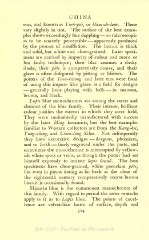Page 388 - Oriental Series Japan and China, Brinkly
P. 388
CHINA
eras, and known as Tueh-pai, or blanc-de-lune. These
vary slightly in tint. The surface of the best exam-
ples shows exceedingly fine dappling so microscopic
as to be scarcely perceptible apparently produced
by the process of insufflation. The biscuit is thick
and solid, but white and close-grained. Later speci-
mens are marked by impurity of colour and more or
less faulty technique ; their lilac assumes a dusky
shade, their pate is comparatively coarse, and their
glaze is often disfigured by pitting or blisters. The
potters of the Taou-kwang and later eras were fond
of using this impure lilac glaze as a field for designs
generally lions playing with balls in maroon,
brown, and black.
Lapis blue monochromes are among the rarest and
choicest of the blue family. Their intense, brilliant
colour justifies the esteem in which they were held.
They were undoubtedly manufactured with success
by the later Ming keramists, but the best examples
familiar to Western collectors are from the Kang-hsi,
Tung-ching, and Chun-lung kilns. Not infrequently
they have decorative designs dragons, phoenixes,
and so forth finely engraved under the paste, and
sometimes the monochrome is interrupted by yellow-
ish white spots or veins, as though the potter had set
himself expressly to imitate lapis lazuli. The best
specimens have close-grained, white porcelain pdtey
but even in pieces dating as far back as the close of
the eighteenth century comparatively coarse brown
biscuit is occasionally found.
Mazarin blue is the commonest monochrome of
this family. With regard to period the same remarks
apply to it as to Lapis blue. The points of excel-
lence are velvet-like lustre of surface, depth and
3*4

